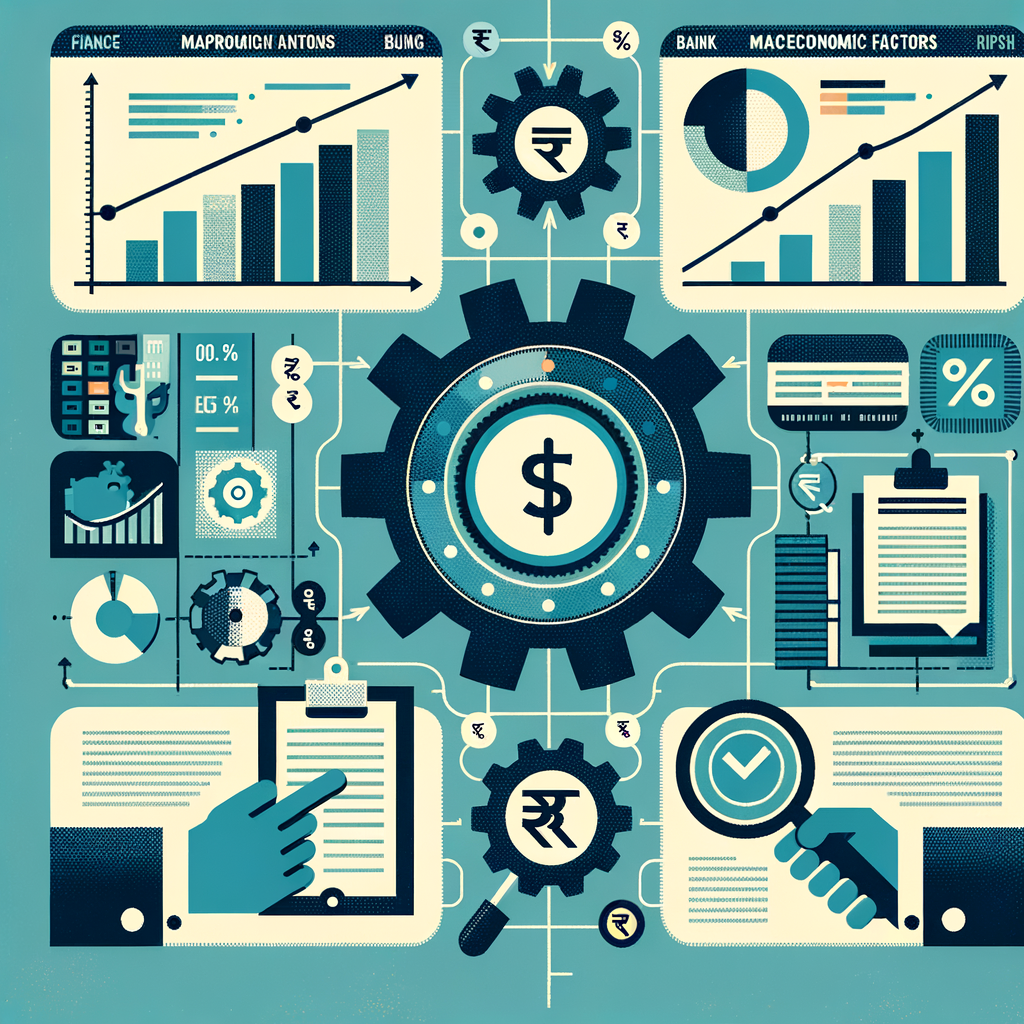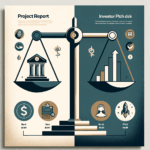How do Macroeconomic Factors Impact Bank Loan Terms Reflected in Project Reports?
Planning to get a Bank Loan for Startup Business to start your new business or expand an existing one? While your business plan and credit score are vital, there are larger forces at play that can significantly influence the deal you get. The overall health of the Indian economy plays a direct and often underestimated role in what a bank is willing to offer you. The relationship between macroeconomic factors and bank loan terms is a crucial concept for any aspiring entrepreneur or borrower to grasp.
This post will break down the key macroeconomic indicators in India that lenders watch closely. We’ll explain exactly how they affect your loan’s interest rate, approved amount, and other critical conditions. Most importantly, we’ll guide you on how to proactively address these factors in your project report to strengthen your application and improve your chances of success. A proper grasp of this subject is essential for understanding loan terms macroeconomics India. A well-prepared project report that acknowledges these economic realities is your first step towards securing the financing you need.
What are Macroeconomic Factors and Why Do They Matter for Your Loan?
Before diving into the specifics of your loan, it’s important to understand the big picture. Macroeconomic factors are broad economic indicators that reflect the performance, structure, and behavior of an entire country’s economy, not just a single company or industry. Think of them as the vital signs of the national economy. For anyone seeking financing, these factors are not just abstract numbers on a news channel; they directly influence a bank’s policies, risk appetite, and the cost of money itself.
When banks decide whether to lend you money, they are assessing risk. Part of that risk is you and your business plan, but a huge part is the economic environment your business will operate in. A strong economy means more opportunities and lower risk, while a weak economy signals potential challenges. Therefore, the macroeconomic impact on financing India is profound, shaping the lending landscape for both individuals and businesses. Understanding these macroeconomic factors bank loan terms India is the first step to navigating the loan process successfully.
Defining Key Macroeconomic Indicators in India
To understand how the economy affects your loan, you need to know what to look for. Here are the four key indicators that banks in India monitor constantly.
- Inflation Rate: In simple terms, inflation is the rate at which the general level of prices for goods and services is rising, which means your money buys less than it used to. High inflation increases the cost of living for individuals and the cost of operations (raw materials, transport, wages) for businesses. The Reserve Bank of India (RBI) is tasked with keeping inflation under control, typically within a target range. You can monitor the latest data on the official Reserve Bank of India (RBI) website.
- Repo Rate: This is arguably the most powerful tool the RBI uses and has the most direct impact of macroeconomic factors on loans India. The repo rate is the interest rate at which the RBI lends money to commercial banks like SBI, HDFC, or ICICI. When the RBI wants to control inflation, it increases the repo rate, making borrowing more expensive for banks. Banks, in turn, pass this cost on to customers. Conversely, when the RBI cuts the repo rate to stimulate economic activity, bank loans become cheaper. You can always find the current rate on the RBI’s Policy Rates page.
- Gross Domestic Product (GDP) Growth: GDP represents the total monetary value of all goods and services produced within India over a specific period. A high and steady GDP growth rate indicates a healthy, expanding economy where businesses are thriving and people are earning more. This gives banks the confidence to lend. Low or negative GDP growth signals an economic slowdown or recession, making lenders more cautious.
- Unemployment Rate: This measures the percentage of the labour force that is without jobs but is available for and actively seeking work. A high unemployment rate can be a sign of economic distress. For lenders, it signals that consumers may have less disposable income and businesses may face weaker demand, increasing the risk of loan defaults.
The Direct Link: How Macroeconomic Factors Influence Bank Loan Terms in India
Now that we’ve defined the key indicators, let’s connect the dots. These large-scale economic trends don’t just stay in financial news headlines; they trickle down and directly shape the terms of your loan agreement. The interplay between bank loan terms and macroeconomics India is a dynamic relationship that determines the cost and availability of credit across the country. Understanding this link is crucial because it affects your business’s financial health from day one. Here’s a detailed breakdown of how macroeconomic factors bank loan terms are connected.
Impact on Your Interest Rate (The Cost of Borrowing)
The most visible impact is on your interest rate. In India, most retail and MSME loans sanctioned since October 2019 are linked to an External Benchmark Lending Rate (EBLR), and for the majority of banks, this benchmark is the RBI’s Repo Rate. This creates a direct and transparent transmission mechanism. When the RBI increases the repo rate to fight inflation, your bank’s cost of funds goes up almost immediately. This increase is passed on to you through a higher interest rate on your loan, which means your Equated Monthly Instalment (EMI) will increase if you’re on a floating rate. Conversely, a repo rate cut by the RBI leads to lower interest rates, making borrowing cheaper and potentially reducing your EMI. This direct linkage means your loan’s cost is perpetually tied to the central bank’s macroeconomic management strategy.
Impact on Loan Availability (Credit Supply)
The overall health of the economy, primarily measured by GDP growth, heavily influences a bank’s willingness to lend. During periods of robust GDP growth and positive economic sentiment, banks are generally more optimistic about the future. They perceive a lower risk of default as businesses are expected to grow and individuals are likely to have stable incomes. This confidence translates into a looser credit supply; banks are more eager to lend, approval processes may be faster, and they might compete for your business with attractive offers. Conversely, during an economic slowdown or recession (low GDP growth), fear and uncertainty dominate. Banks tighten their lending standards significantly to protect themselves from potential losses. They become more risk-averse, scrutinize applications more rigorously, and may reject proposals they would have approved in better times. This “credit crunch” can make it much harder to secure a loan, regardless of how strong your individual business plan is.
Impact on Loan-to-Value (LTV) Ratio and Margin Money
The Loan-to-Value (LTV) ratio is the percentage of a project’s or asset’s total cost that a bank is willing to finance. The remaining portion, which you must fund from your own pocket, is called margin money. Macroeconomic conditions heavily influence the LTV ratios that banks are comfortable offering. In a stable and growing economy, banks might be willing to offer a high LTV, for instance, funding 80% or even 90% of a property’s value or a project’s cost. This reduces the upfront financial burden on you. However, in an uncertain economic climate marked by high inflation or low GDP growth, banks become more conservative. To create a larger safety cushion for themselves, they may reduce the LTV ratio. For example, instead of funding 80% of your project, they might only agree to fund 70% or 65%. This means you are required to contribute a much larger share as margin money, which can be a significant barrier for many small business owners.
How to Address Macroeconomic Factors in Your Project Report for a Bank Loan
A well-crafted project report is your primary tool for communicating with a lender. It’s not just a document with numbers; it’s your business’s story and your argument for why it deserves funding. To make that argument compelling, you must show the bank that you are not operating in a vacuum. Acknowledging the broader economic environment and demonstrating how your business can navigate it is a sign of a diligent, aware, and low-risk borrower. This section is your practical guide to incorporating macroeconomic analysis bank loans India into your report, directly addressing the requirements for project reports bank loan terms India.
Why Your Project Report Needs a Macroeconomic Overview
Simply put, a project report that ignores the current economic climate is incomplete and unrealistic. Banks are not just investing in your idea; they are investing in your idea’s ability to succeed *in the current market*. By including a macroeconomic overview, you achieve several key objectives. First, you demonstrate professionalism and thoroughness, showing the lender you’ve done your homework. Second, you build credibility by acknowledging potential risks (like inflation or high interest rates) instead of ignoring them. Third, it allows you to frame your business’s strengths and opportunities within the context of the national economy, making your projections more believable. A project report is a key element for all project reports and loans India, and a strong macroeconomic section can set you apart from other applicants.
Key Sections to Include Macroeconomic Analysis
Don’t just add a generic paragraph about the economy. Integrate your analysis thoughtfully into the relevant sections of your project report for maximum impact.
- Market & Industry Analysis:
This is the perfect place to set the stage. Go beyond just describing your target market.
Actionable Detail: Start by stating the current national GDP growth rate and the forecast for your specific industry. Use credible sources for this data. Then, explain how this broader trend supports your business’s potential. For example, if the government is pushing for infrastructure development and your business supplies construction materials, you have a strong, macro-level tailwind.
Example: “The Indian economy is projected to grow at 7% in the current fiscal year. The logistics and warehousing sector, our target industry, is expected to outpace this, growing at 10-12% due to the government’s National Logistics Policy and rising e-commerce penetration. Our sales projections are conservatively based on capturing a small fraction of this industry-wide growth.” - Financial Projections & Feasibility:
Your financial models must be grounded in reality, which starts with A Guide to Budgeting and Financial Planning for Startups. This is where macroeconomic assumptions directly impact your numbers.
Actionable Detail: When projecting your costs and profitability, use realistic interest rate assumptions for your loan. Don’t use a generic or overly optimistic rate. Mention the current lending rates linked to the RBI’s repo rate and use that as your baseline in calculating projected EMIs, interest costs, and your break-even point.
Show Risk Mitigation: This is crucial for building a lender’s confidence. Include a sensitivity analysis in your report. This analysis shows how your business’s profitability and repayment capacity would be affected under different scenarios. For example, create a table showing your net profit if interest rates rise by 0.5%, 1%, or 1.5%. This demonstrates foresight and proves you have a plan to manage financial pressures. - SWOT Analysis (Strengths, Weaknesses, Opportunities, Threats):
Your SWOT analysis should explicitly include macroeconomic factors.
Actionable Detail: Use the ‘Opportunities’ and ‘Threats’ sections to list external economic factors.- Opportunities: “Strong GDP growth creating higher consumer demand,” “Government’s ‘Make in India’ initiative supporting domestic manufacturing,” or “Falling repo rates leading to cheaper future expansion capital.”
- Threats: “Sustained high inflation increasing raw material and operational costs,” “Potential for future repo rate hikes impacting profitability,” or “An economic slowdown leading to reduced customer spending.”
Conclusion
As we’ve seen, the link between macroeconomic factors and bank loan terms is direct, powerful, and undeniable. For any small business owner or salaried individual in India seeking a loan, looking beyond your own financial statements is no longer optional—it’s essential. Indicators like the Inflation Rate, RBI’s Repo Rate, and national GDP growth aren’t just topics for economists; they are practical variables that determine the cost, size, and availability of your loan. A proactive approach is your best strategy. By understanding these forces and intelligently addressing them in your project report, you do more than just complete a formality. You demonstrate foresight, build credibility with lenders, and significantly strengthen your loan application, which can help you secure the funding needed to turn your vision into reality.
Navigating the complexities of a project report can be challenging. Don’t let a poorly drafted report stand between you and your business goals. Contact TaxRobo’s financial experts today. We specialize in creating comprehensive, bank-ready project reports that address all key financial and macroeconomic considerations.
Frequently Asked Questions (FAQs)
1. What is the single most important macroeconomic factor for my loan interest rate?
The RBI’s Repo Rate. In India’s current lending framework, commercial bank lending rates for most new retail and MSME loans are directly benchmarked against it. When the repo rate changes, the interest rate on floating-rate loans (which include most home, business, and personal loans) almost always follows suit within the next interest reset period.
2. Can a good project report help me get better loan terms in a weak economy?
Absolutely. In a weak economy, banks become extremely cautious and risk-averse. A generic or weak application is likely to be rejected outright. However, a detailed project report that includes a thorough macroeconomic analysis for bank loans, presents realistic financial projections, and clearly outlines risk mitigation strategies (like a sensitivity analysis) can build a lender’s confidence in your specific proposal. Knowing how do I prepare a comprehensive bank project report for a business loan? is key. It shows you are prepared, which may lead to approval and potentially more favourable terms than you would otherwise receive.
3. Do macroeconomic factors affect fixed-rate and floating-rate loans differently?
Yes, significantly. For a floating-rate loan, your interest rate and EMI are directly exposed to macroeconomic shifts. If the RBI raises the repo rate, your EMI will likely increase. For a fixed-rate loan, your interest rate is locked in for the entire loan tenure. This protects you from future rate hikes but also means you won’t benefit if macroeconomic conditions lead to rate cuts. The choice depends on your risk appetite and your view of future interest rate movements.
4. How does high inflation impact my business loan application?
High inflation has a dual impact. First, it often prompts the RBI to increase the repo rate to cool down the economy, which will make your loan more expensive from the start. Second, it directly affects your business’s viability. In your project report, you must convincingly show the bank how you will manage rising input costs (like raw materials, fuel, and labour) without letting them erode your profit margins and jeopardise your ability to repay the loan. This could involve strategies like locking in supplier prices, improving operational efficiency, or having a well-justified pricing strategy.



